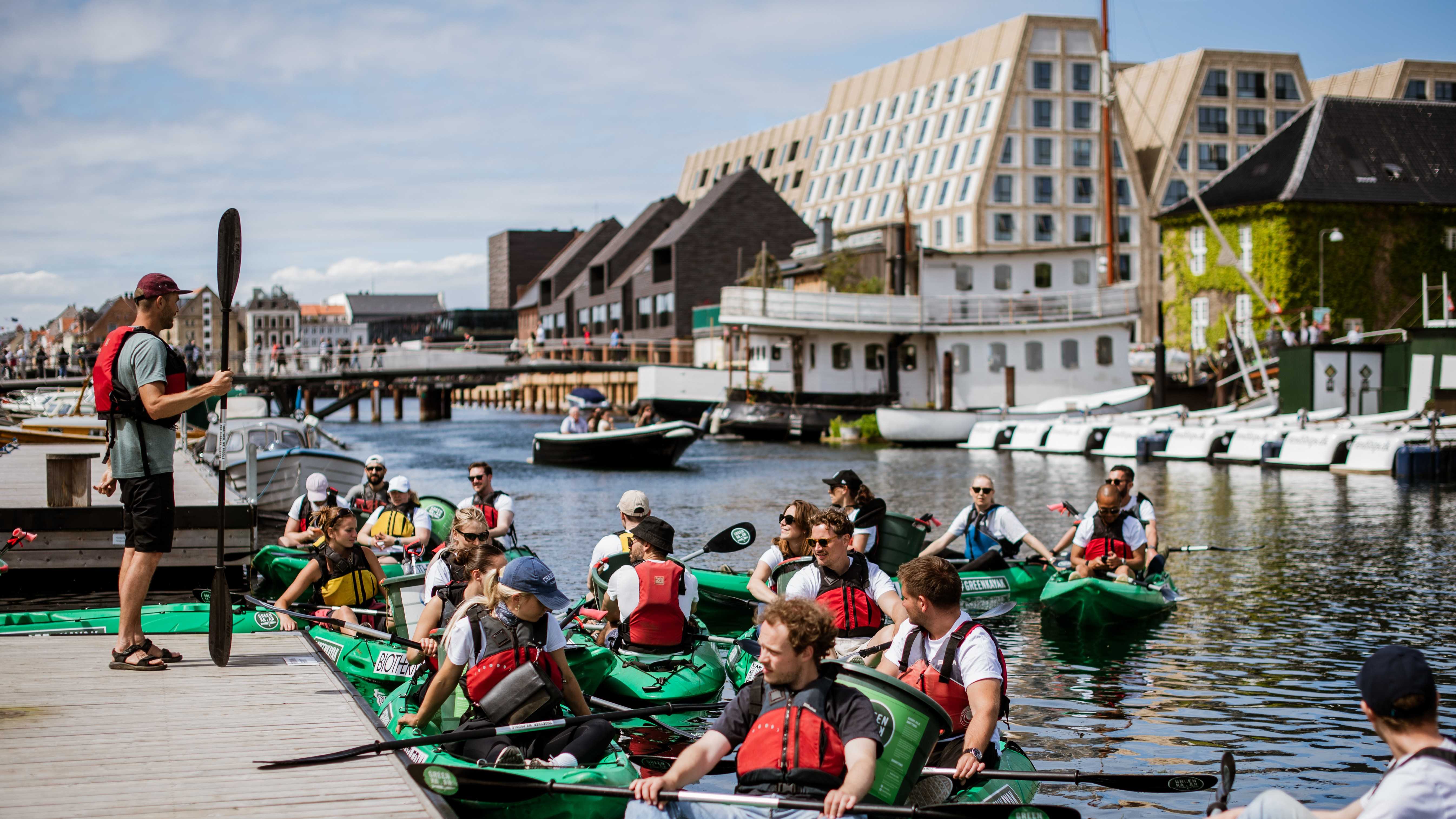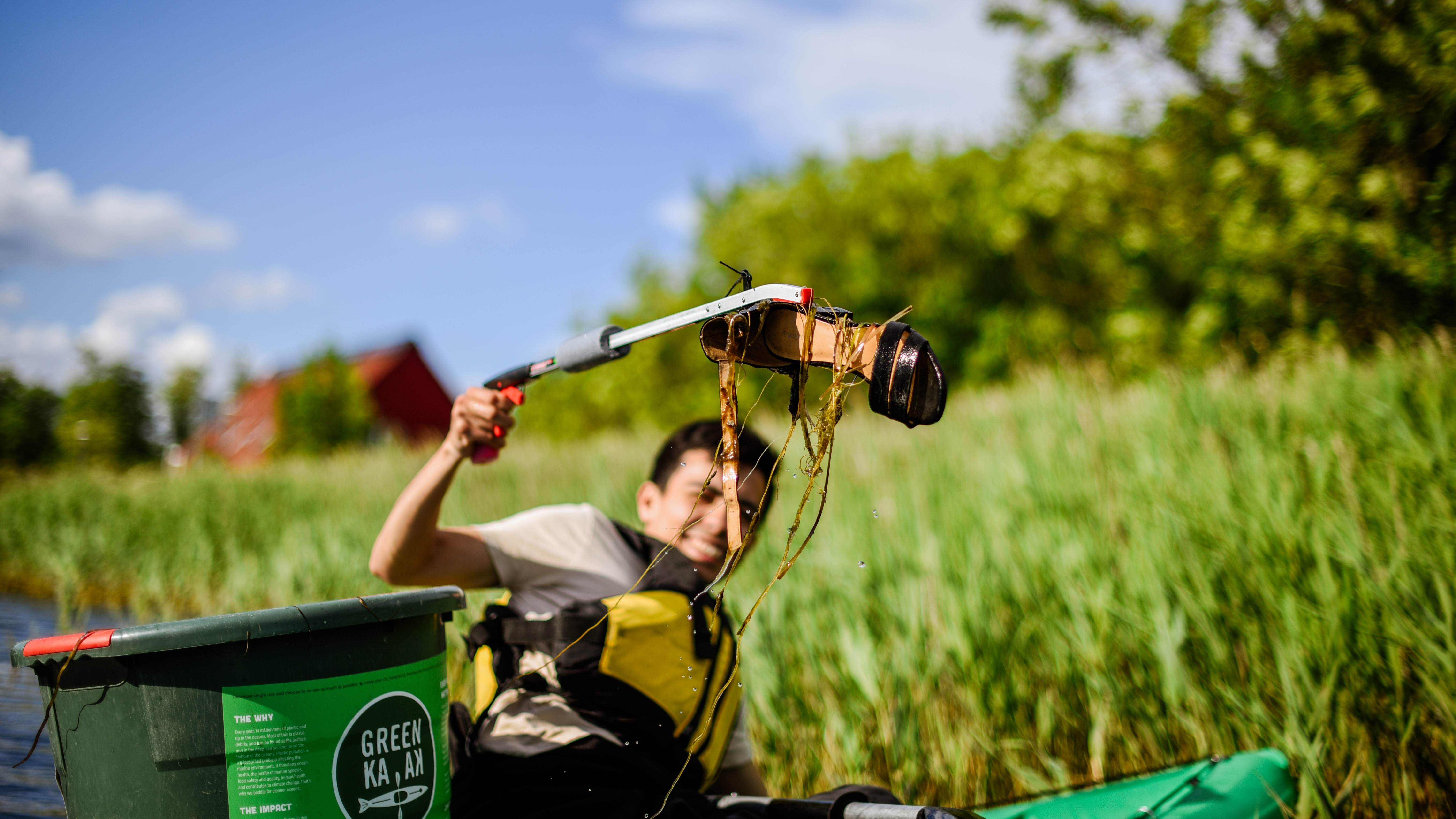Danish GreenKayak promotes sustainable tourism
Rent a kayak and pick litter out of Copenhagen’s harbour. That was the simple idea Tobias Weber-Andersen had while out running one day in 2017. Nine years later, GreenKayak is a tourism magnet with kayaks in four Nordic countries, plus Germany and Japan.
134 tonnes. That is how much litter tourists and locals have fished out of the waters in Copenhagen and other Nordic and German cities in the nine years since GreenKayak started operating.
At the same time, the small Danish NGO has boosted ocean-friendly tourism in Copenhagen and other major cities in the Nordic region.
So says Tobias Weber-Andersen, the GreenKayak founder. His company now operates 80 kayaks in Danish, Swedish, Norwegian and Finnish cities. There are a further 22 kayaks in Hamburg and Berlin, and a single green kayak is pootling around in Japan’s capital, Tokyo.
“Our concept has made it popular for tourists to pick litter while visiting a city. Many tourists would like to give something back to the city and experience it in a different way, taking that experience home with them, where they also make greener choices.”
A big impact
85,000 people have so far used GreenKayak’s vessels and gathered litter, many of them tourists. GreenKayak has conducted surveys among their users – called “volunteers” – and they say the litter collection has influenced their purchasing habits.

It started in Copenhagen but has spread to several cities across the Nordics and Europe. Photo: GreenKayak
“Fishing large amounts of plastic and other litter out of the water makes an impression. On average, each Kayak collects three kilos of waste during one trip,” says Tobias Weber-Andersen.
GreenKayak has two full-time staff – himself and co-founder Oke Carstensen. They also have a part-time employee plus a handful of kayak instructors hired by GreenKayak to run kayaking events – for instance school trips and company outings where employees pick litter in pairs.
“It is a very popular CSR (Corporate Social Responsibility) activity among companies and serves as a green alternative to taking staff to a bowling alley,” says Tobias Weber-Andersen.
For now, these types of events are available in Copenhagen, Berlin and Hamburg.
Win-win
GreenKayak funds salaries and operations through “co-branding partnerships”. Companies pay to have kayaks emblazoned with their logos, and every month they get a report from GreenKayak detailing how many tourists and other people have been in that particular kayak and how many kilos of litter have been collected.
The companies can then share this information publicly and help to raise further awareness about the issue of litter being dumped in our waterways.
Tobias Weber-Andersen does not consider GreenKayak to be a competitor to other companies hiring out kayaks to tourists and others.
“This also helps commercial players because it increases people’s interest in using kayaks.”
Before GreenKayak, Tobias was a professional kayak instructor and outdoor activity guide. He was also a co-owner of Kayak Bar and Kayak Republic – bars located in Copenhagen Harbour, where you can rent or borrow kayaks.
This is where Tobias Weber-Andersen discovered the sheer amount of litter in the water.
“The water was pretty much my office back then, and it was overflowing with litter. This frustrated me, so we created events where we invited people to come and collect the litter. Many did so, but the day after, there was litter everywhere again.”
Meaningful work
Tobias Weber-Andersen was very moved by the impact of events that involved large groups, including many foreign tourists who would take their experiences back home with them.
So he started thinking about possible solutions, and during a run, he suddenly came up with the idea for GreenKayak.
The concept was initially called Miljøkajakken (the Environment Kayak), but the Danish letter ø was an obstacle to expansion into other countries. So in 2019, the NGO got its current name.
Having a meaningful job is important to GreenKayak’s founder, Tobias Weber-Andersen. There should be a greater purpose than just making money, he says. He has always felt connected to the ocean. That is where he finds calm and inspiration. Giving back to nature through his job is more than a choice, he says.
“It’s a mission, and my motivation is to start a fire in others to choose the same path. Nature needs our help.”
His job at GreenKayak, therefore, gives him a lot of purpose.
“My job is very purposeful. The bar where I used to work was about getting people to buy beer. Now I send people out on the water while they also collect litter and share their experience with the world afterwards."
Beyond removing litter, Tobias Weber-Andersen also finds satisfaction in telling the world that harbours and oceans are recreational areas which can be used and where you can swim, but that this also leads to a lot of waste that should not end up in the water.
Praise from the tourism industry
GreenKayak works with other NGOs, organisations and authorities in Denmark, elsewhere in the Nordics and internationally. GreenKayak has received several environmental awards and has long since appeared on the radar of the UN and the EU as an important player in sustainability.
This includes recognition from the European Environment Agency (EEA), which supplies the EU with information to support Europe’s environmental and climate goals. The EEA holds GreenKayak up as a good example of a local initiative in a report on plastic waste.

According to UN estimates, there are now between 75 and 199 million tons of plastic waste in the ocean. Kayakers are helping to clean it up. Photo: GreenKayak
GreenKayak has also been praised by Wonderful Copenhagen, the city’s official tourism organisation, which works to push tourism in a more sustainable direction.
“The idea of combining kayaking in the harbour with gathering litter aligns very well with the growing trend of tourists wanting to make a positive contribution to the places they visit,” says Søren Tegen Pedersen, CEO of Wonderful Copenhagen.
He quotes new figures from Booking.com showing seven in ten tourists want to leave destinations in better condition than they found them.
A gap between intent and action
When it comes to the tourists’ actual actions, things look less sustainable. Four in five (82 per cent) want to act sustainably, but two in ten (22 per cent) have actually changed their behaviour, according to 2025 numbers quoted on Wonderful Copenhagen’s website.
This gap between intent and action is the reason why Wonderful Copenhagen has launched a nudging initiative, CopenPay.
“We reward more conscious actions from tourists, and in doing so, we aim to raise their awareness of the impact of the many choices they make when they travel. GreenKayak’s concept aligns very well with this,” says the Wonderful Copenhagen CEO.
CopenPay makes it possible to pay for attractions in Copenhagen through environmentally friendly actions, including a trip with GreenKayak.
- Look after the ocean
-
GreenKayak works to reduce the amount of waste floating in our coastal waters. The idea is simple – take a free GreenKayak tour in exchange for collecting trash. Photo: Daniel Rasmussen
 Follow us on Facebook
Follow us on Facebook
